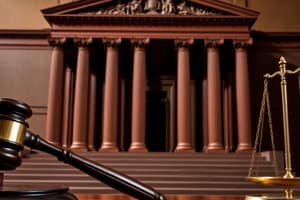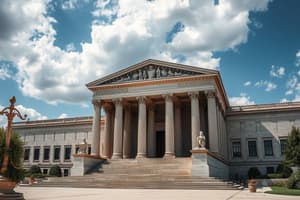Podcast
Questions and Answers
Match the following terms with their definitions:
Match the following terms with their definitions:
Judiciary = Judges taken collectively Legislature = An elected body with authority to make laws Plea Bargain = A negotiated agreement between prosecution and defendant SCOTUS = Supreme Court of the United States
Match the following concepts with their descriptions:
Match the following concepts with their descriptions:
Juvenile Justice = System designed to handle lawbreaking by minors Unconstitutional = Not in accordance with the Constitution Nonsystem Argument = Components of criminal justice system are in conflict Procedural Due Process = Requirement for fair treatment in the justice system
Match the following entities with their roles:
Match the following entities with their roles:
United States Supreme Court = Highest court in the United States SCOTUS = Informal abbreviation for the Supreme Court Legislature = Responsible for creating laws Judiciary = Collective term for judges
Match the following definitions with their corresponding terms:
Match the following definitions with their corresponding terms:
Match the legal terms with their definitions:
Match the legal terms with their definitions:
Match the branches of government with their functions:
Match the branches of government with their functions:
Match the descriptors with their relevant concepts:
Match the descriptors with their relevant concepts:
Match the court concepts with their functions:
Match the court concepts with their functions:
Match the legal principles with their implications:
Match the legal principles with their implications:
How does the common law influence the legal system in the United States?
How does the common law influence the legal system in the United States?
What principle is embodied by the concept of Due Process?
What principle is embodied by the concept of Due Process?
Which statement best describes the concept of Procedural Due Process?
Which statement best describes the concept of Procedural Due Process?
What does the term Penal Code refer to in the context of criminal justice?
What does the term Penal Code refer to in the context of criminal justice?
What is a key feature of a plea bargain in the criminal justice system?
What is a key feature of a plea bargain in the criminal justice system?
Flashcards are hidden until you start studying
Study Notes
Legal System and Structure
- Appellate Court: Rehears cases from trial courts, reviewing previous judicial decisions.
- Dual Court System: Features both state and federal courts, reflecting the American governmental framework.
- Congress of the United States: Comprises the U.S. House of Representatives and Senate; responsible for legislative authority.
- Three Branches of Government: Consist of executive, legislative, and judicial branches as defined by the Constitution.
Legal Framework and Principles
- Bureau of Justice Statistics (BJS): Collects and disseminates information on crime, offenders, victims, and justice systems.
- Code: Comprehensive law collections organized by subject.
- Common Law: Originating in England, focuses on judicial decisions and precedents, used in the U.S.
- Constitution: Fundamental principles governing a nation or state, establishing legal frameworks.
- Criminal Code: Governs criminal law within the United States Code or state codes.
- Penal Code: A set of laws defining crimes and punishments, representing substantive criminal law.
Judicial Processes
- Decisions (courts): Written opinions from appellate courts, binding in common law jurisdictions.
- Judicial Review: Enables the Supreme Court to assess the constitutionality of legislative actions.
- Federal Rules of Criminal Procedure: Regulatory framework overseeing federal criminal prosecutions.
Individual Rights and Legal Protections
- Due Process: Guarantees fair treatment in the criminal justice system for defendants.
- Procedural Due Process: Ensures fundamental fairness in legal proceedings for individuals.
- Infancy Defense: Doctrine that children are incapable of wrongdoing, exempting them from prosecution.
Government and Justice Efficiency
- Executive Branch: Manages public affairs and enforces laws and policies.
- Effectiveness: Involves equitable justice and adherence to constitutional rights for offenders.
- Efficiency: Utilizes resources economically to meet legal goals and enhance public safety.
Justice System Dynamics
- Fairness: Advocates for equal treatment of offenders and equitable consideration in sentencing.
- Nonsystem Argument: Suggests conflict and disorganization within the criminal justice system, indicating a lack of cohesion.
- Juvenile Justice: Specialized components within the justice system addressing offenses by minors.
Legal Negotiations and Agreements
- Plea Bargain: A deal where the defendant admits guilt to a lesser charge or sentence than potentially pursued at trial.
- Hierarchical Structure: Organizational model in which elements are ranked based on authority or importance.
Supreme Court Overview
- SCOTUS (Supreme Court of the United States): The highest judicial authority, consisting of eight Justices and one Chief Justice.
- Unconstitutional: Identifies laws or actions that violate constitutional provisions.
Legal System and Structure
- Appellate Court: Rehears cases from trial courts, reviewing previous judicial decisions.
- Dual Court System: Features both state and federal courts, reflecting the American governmental framework.
- Congress of the United States: Comprises the U.S. House of Representatives and Senate; responsible for legislative authority.
- Three Branches of Government: Consist of executive, legislative, and judicial branches as defined by the Constitution.
Legal Framework and Principles
- Bureau of Justice Statistics (BJS): Collects and disseminates information on crime, offenders, victims, and justice systems.
- Code: Comprehensive law collections organized by subject.
- Common Law: Originating in England, focuses on judicial decisions and precedents, used in the U.S.
- Constitution: Fundamental principles governing a nation or state, establishing legal frameworks.
- Criminal Code: Governs criminal law within the United States Code or state codes.
- Penal Code: A set of laws defining crimes and punishments, representing substantive criminal law.
Judicial Processes
- Decisions (courts): Written opinions from appellate courts, binding in common law jurisdictions.
- Judicial Review: Enables the Supreme Court to assess the constitutionality of legislative actions.
- Federal Rules of Criminal Procedure: Regulatory framework overseeing federal criminal prosecutions.
Individual Rights and Legal Protections
- Due Process: Guarantees fair treatment in the criminal justice system for defendants.
- Procedural Due Process: Ensures fundamental fairness in legal proceedings for individuals.
- Infancy Defense: Doctrine that children are incapable of wrongdoing, exempting them from prosecution.
Government and Justice Efficiency
- Executive Branch: Manages public affairs and enforces laws and policies.
- Effectiveness: Involves equitable justice and adherence to constitutional rights for offenders.
- Efficiency: Utilizes resources economically to meet legal goals and enhance public safety.
Justice System Dynamics
- Fairness: Advocates for equal treatment of offenders and equitable consideration in sentencing.
- Nonsystem Argument: Suggests conflict and disorganization within the criminal justice system, indicating a lack of cohesion.
- Juvenile Justice: Specialized components within the justice system addressing offenses by minors.
Legal Negotiations and Agreements
- Plea Bargain: A deal where the defendant admits guilt to a lesser charge or sentence than potentially pursued at trial.
- Hierarchical Structure: Organizational model in which elements are ranked based on authority or importance.
Supreme Court Overview
- SCOTUS (Supreme Court of the United States): The highest judicial authority, consisting of eight Justices and one Chief Justice.
- Unconstitutional: Identifies laws or actions that violate constitutional provisions.
Studying That Suits You
Use AI to generate personalized quizzes and flashcards to suit your learning preferences.




